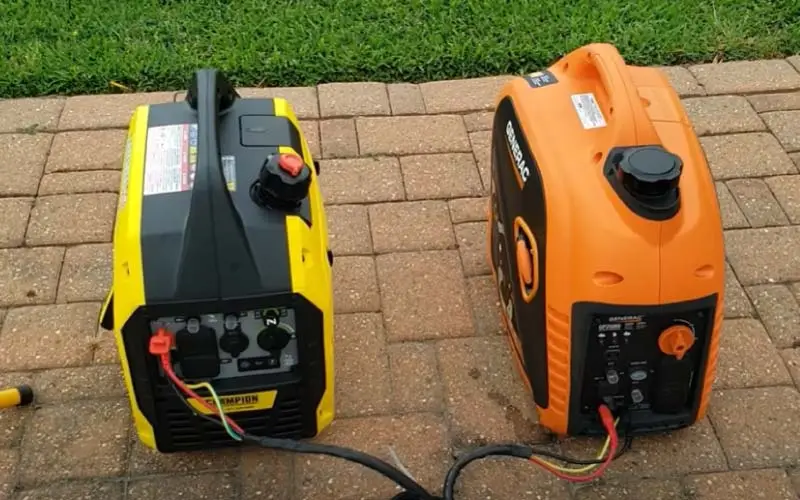How to Parallel Generators? – [Safely Double the Power]
Due to the increasing demand for power, parallelling is the only effective and reliable tool to double or even triple the power by simply connecting compatible and parallel-ready machines through the parallel kit.
After conducting multiple experiments, we are now ready to answer your burning questions like “How to parallel generators? What things should be taken into account and what are the major benefits of combining the two machines in parallel?

What Is Generator Paralleling?
Paralleling is a method to couple/combine the different or same brand generators irrespective of their sizes to get double or triple power.
Paralleling could be done with a dedicated parallel kit or parallel cables, also the generators should be parallel-ready with similar electrical properties as well.
How to Parallel Generators?
1. Cross Check the Compatibility of the Generator:
Before paralleling the two machines make sure to read the user manual and look for their output voltages, frequencies, and whether they are parallel-ready or not.
If you found similar Elcertical properties and your machine is parallel-ready, you can make the parallel connection safely; however, with incompatible power ratings, the voltage-sensitive appliance may be damaged.
NOTE: The operation manual would be a helping hand in finding out the exact electrical properties, however, If you are still confused or unsure about it, seek help from a professional electrician.
2. Use a Compatible Parallel Kit:
Purchase a compatible parallel kit from any reputable brand and connect it to the dedicated parallel ports of the generators.
Most of the parallel kits consist of 6 terminals 4 for paralleling and two for grounding the generators. Read the operational manual before making the connections.

3. Keep an Eye on The Generator:
Monitor the generators for about 5 minutes (especially if you have paralleled the non-inverter machines) If you found something wrong turn off the generators in an instant.
CAUTION: To avoid electrocutions the parallel connection should be made before firing up the generators.
What Things Should Be Considered Before Paralleling?
Read The User Manual:
Not all of the generators are parallel-ready, Read the operating manual to find out whether your machine is parallel-ready or not.
Also, you can check out the ports of the generator you own, if it’s parallel-ready then it must have parallel ports on the back.
Check for the Compatible Engines:
The engine speed of both generators should be perfectly synced, we recommend parallelling the two same inverter machines with the same power and engine speed, however, if you have purchased from a different brand make sure to read the user manual first and look for their engine speeds, if you found them compatible go for the parallel connections.
Check for the Electrical Properties:
Electrical properties like frequencies, voltages, and polarity (phase) should be matched before combining the machines. For a successful parallel connection, synchronization of these there parameters (frequencies, voltages, and polarity) should be important.
NOTE: No two machines could provide the same results in terms of voltage, frequency, and polarity even if they are the same model purchased from the same manufacturer.
But how much variation should be acceptable to parallel the machines?
<5% of output voltage wouldn’t be a problem; however, the difference between the phase angles shouldn’t be more than 5o.
The Generator should have the Same Fuel:
To perfectly synchronize the wattages, both of the machines should be operated with the same fuel.
Why Do We Need to Parallel Generators?
A normal portable inverter generator of 2 – 3kW wouldn’t be enough to operate multiple power-hungry appliances simultaneously; however with the parallel connection we can double the power in an instant without buying a bigger machine.
Additionally, it’s much cheaper and more reliable as you don’t have to sell the previously owned unit at half price and buy another expensive one, all you need to purchase a compatible smaller machine by spending a few hundred bucks.
Besides the cost-effective setup, you will also have a decent portable system as the two lightweight machines provide easier mobility compared to the one heavier.
Are Paralleling Generators Safe?
Yes, Paralleling Generators is a safe and reliable process unless you have done something wrong without following the owner’s manual.
The following things should be taken into account to make a successful parallel connection.
- Read the user manual and look for the manufactures statement.
- The generator should be parallel-ready.
- Electrical properties like Frequencies, Voltages, THD, and Polarity (Phase) should be properly synced.
- Don’t ever try the DIY hacks as paralleling isn’t a task of non-technical persons.
Recommended Read: Safety Tips for Operating the Generators
How Much You Will Have to Spend on Paralleling?
The cost of paralleling the generators is highly dependent on several factors like the size, brand, and the type of generators you are going to couple.
Premium brands like Honda may cost you a bit more compared to the ordinary brands, also if you are going to parallel bigger units of 3.5 – 5kW you may have to spend more compared to the smaller machines.
Furthermore, a decent durable parallel kit from WEN, Champion or Generac will also you about $50 – $70.
What are the Advantages of Running Parallel Generators?
More Power:
Due to the increasing demand for power, Paralleling is the only weapon to double the power by adding another smaller inverter machine without selling the older one at a cheaper price tag.
Greater Portability:
Two small machines are relatively easier to carry compared to the one larger machine, as a heavier unit like Westinghouse 15000 watts need effort while loading and unloading, however, the smaller inverter generator like Honda EU2200i or Champion 2000 watt can be carried like a briefcase.
You will Still Have Option “B”:
In case one inverter generator is failed you will have still option “B” to operate another one to run the smaller loads, however in the case of the bigger one you will not have any option unless you own another one in the backup.
Cost Effectiveness:
If your previously owned inverter generator is not sufficient to fill your powering needs, it’s wise to spend a few hundred dollars on another similar machine rather than selling the old one at a significant loss.
Though buying a bigger machine is another option, still we recommend spending less to get a parallel kit and a similar unit to double the power.
In case your power needs are more than double then the only option remains to go for the bigger unit of 10 – 15kW.
Easier Maintenance:
I understand your concern that a single bigger unit will be easier to maintain compared to the two smaller machines but let me tell you the truth, smaller units have a pretty straightforward maintenance procedure and can be done within a few minutes.
Greater Control on Power:
If your powering need is low you can operate one smaller machine rather than starting a bigger machine that consumes more fuel and emits relatively higher noise compared to the smaller one.
Decent Efficiency:
As a matter of fact, a Single machine provides less than 30% of efficiency at the smaller loads, however, a small inverter generator is specifically optimized to ensure 80% of efficiency even with the smaller loads.
In addition to that, paralleling the inverter generators provide a significantly higher runtime compared to the one bigger machine.
Quiet Operation:
Smaller or medium-sized inverter generators are less noisy compare to the bigger non-inverter open-frame machine.
Should I Buy a Larger Generator Instead of Paralleling?
Depends on the situation, if you own a smaller inverter machine and you need 1.5k – 2kW more, then it is wise to spend on another smaller inverter machine, however, if your need is more than 2 – 4kW I recommend going for a single bigger unit rather than combining 3 -4 smaller machines.
Can You Parallel Non-inverter Generators?
Yes, you can but not recommended by the experts because of the differences in output, reduced efficiency, load-balancing challenges and synchronization limitations
Can You Parallel Two Different Brand Generators?

Yes, you can, but make sure to read the user manual and cross-check the compatibility and electrical properties like frequency, voltage, etc. of both machines.
Can We Connect Two Different Sized Generators?
Yes, you can parallel the two compatible generators irrespective of their sizes, however, if one of them will be overloaded during the operation you will lose the connection.
As per my test with Honda EU2200i and EU3000is, I was getting around 4Kw output, after exceeding it the Honda EU2200i becomes overloaded and the connect lost.
The bottom line is you can parallel the different-sized generators as long as you are balancing both sides.
NOTE: If you own a set of different-sized machines, you can still utilize the remaining wattages of the bigger machine by connecting the load to the bigger unit alone; make sure to attach the load to the outlet of the bigger generator not in the parallel kit.
Final Words
Paralleling the generator is the only way to double your power without spending thousands of bucks on a bigger machine, also you will have greater control over the fuel consumption and power as you can operate “one” machine during low demands.
Hope I have delivered what I promised, if I am missing something, please let me know in the comment section!
Frequently Asked Questions – [FAQS]
How Do Generators Share the Load?
The power of both generators combines with the help of the parallel kit and transfers to the House, RV, or whatever load you are pulling.
Does Paralleling Cause Damage To Generators?
No paralleling is a safe process unless you are going to apply some of the DIY hacks that weren’t recommended by the manufacturers.
Connecting Two Different Generators in Parallel?
Yes, but you have to make sure both generators are parallel-ready with similar electrical properties. Incompatible machines with imbalanced electrical properties will not only restrict the power out but also could damage the appliances.
Are Generator Parallel Kits Universal?
Yes, there is nothing special about the parallel kit as long as both generators are compatible and parallel-ready, you can even use different brands of parallel kits.
Can You Parallel 3 Generators?
Yes, you can, however, you should have to purchase a parallel kit that supports the 3 generators simultaneously. Connecting the three generators through wiring isn’t recommended by any manufacturer as the process is a bit technical and dangerous as well.
Can You Parallel Two Generators to Get 240 Volts?
No, like parallel connection in batteries, the voltage of the parallel generators will be the same, however, the amps and wattage will be doubled.
Can AC Generators Be Connected in Parallel?
Yes, you can, most of the generators produce an alternative current (AC) (SOURCE)
Which Generator Is Most Suitable for Parallel Operation?
As per my experience, the Inverter generators are super reliable and properly configured for paralleling.
NOTE: Open frame non-inverter machines are not suitable for paralleling and require extensive technical knowledge to parallel them safely.
Do Amps Stay the Same in Parallel?
No, the amps will be increased.
Can Generac Generators Run In Parallel?
Yes, if both Generac machines are compatible and parallel ready you can couple them.
What Happens to Wattage in Parallel?
Wattage will be doubled or even triple if you have parallel the three same sized three inverter generators.
Does Voltage Stay the Same in Parallel?
Yes, like a parallel connection in a battery, the voltage will be the same in case of paralleling the generator, however the amps/wattage increases.

Kashif has been a valuable asset to the electric generator industry for over 5 years. Now, As a skilled energy engineer, he’s been on the front lines of diagnosing problems, fixing broken parts, and performing routine maintenance tasks to keep generators running smoothly.
